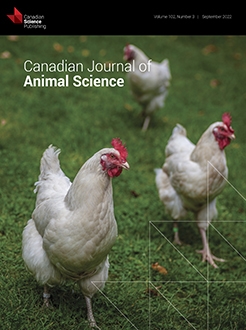The aim of the present study was to determine correlations between udder skin surface temperatures and milk yield and estimated composition in dairy cows. The thermographic images of 34 Polish Holstein–Friesian black-and-white cows were taken in a milking parlor before and after milking. Partial correlation coefficients were calculated between the surface temperatures of the udder hind quarters and milk production traits controlling for age, parity, year, and milking time. Daily milk yield was weakly and nonsignificantly correlated with surface temperatures (rp ranging from −0.19 to 0.21), except for the mean and maximum temperatures of the left hind quarter after milking (rp = 0.40 and rp = 0.38, respectively). There were significant correlations of skin surface temperature with estimated fat content (rp = −0.55 to 0.48), protein content (rp = −0.39 to 0.42), fat yield (rp = −0.42 to 0.54), and protein yield (rp = 0.37 to 0.54). The estimated somatic cell count was significantly correlated with the minimum temperature (rp = −0.54 to −0.36). The estimated urea content was significantly correlated with the minimum temperature (rp = 0.52). A larger sample size is required in future research to confirm these preliminary results.
Le but de la présente étude était de déterminer les corrélations entre les températures de surface de la peau du pis et le rendement et la composition estimés du lait chez les vaches laitières. Les images thermographiques de 34 vaches Holstein–Friesian black-and-white polonaises ont été prises dans une salle de traite avant et après la traite. Les coefficients de corrélation partielle ont été calculés entre la température de surface du pis de l’arrière-train et les caractéristiques de production de lait, en contrôlant pour l’âge, la parité, l’année et l’heure de traite. Il y avait une corrélation faible et non significative entre le rendement quotidien de lait et les températures de surface (rp allant de –0,19 à 0,21), sauf pour la température moyenne et maximale de l’arrière-train gauche après la traite (rp = 0,40 et rp = 0,38, respectivement). Il y avait des corrélations significatives entre la température de surface de la peau avec la teneur estimée en gras (rp = –0,55 à 0,48), la teneur en protéines (rp = –0,39 à 0,42), le rendement en gras (rp = –0,42 à 0,54) et le rendement en protéines (rp = 0,37 à 0,54). Il y avait une corrélation significative entre les estimations de numérations de cellules somatiques et les températures minimales (rp = –0,54 à –0,36). Il y avait une corrélation significative entre la teneur en urée et la température minimale (rp = 0,52). Une plus grande taille d’échantillon est nécessaire pour la recherche future afin de confirmer ces résultats préliminaires. [Traduit par la Rédaction]





